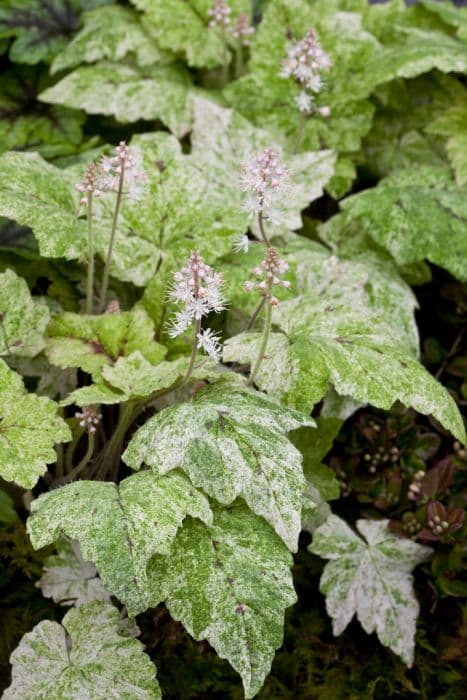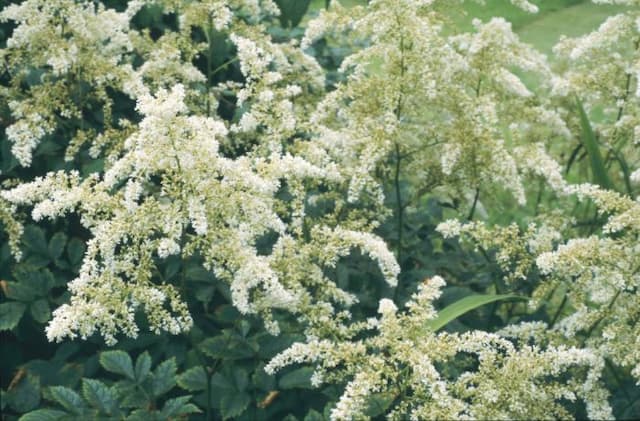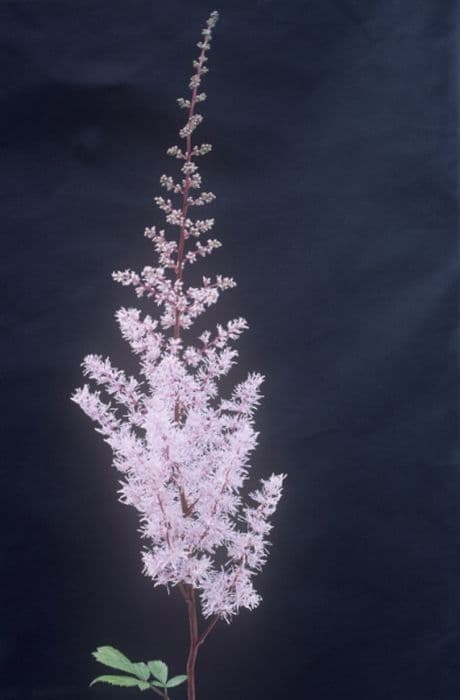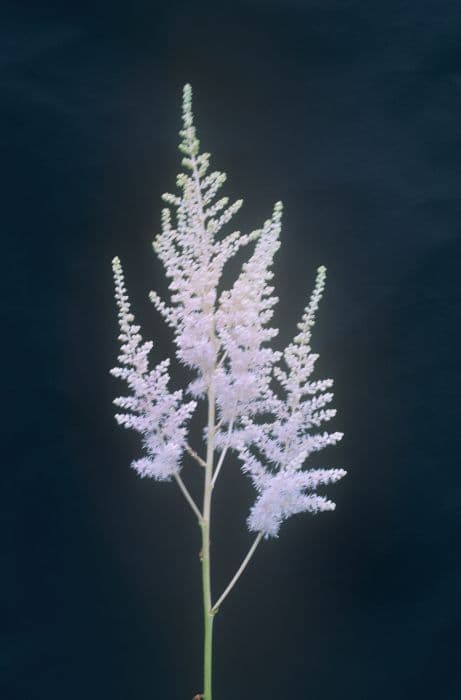Foamflower Tiarella 'Mystic Mist' (PBR) (v)

ABOUT
The Tiarella 'Mystic Mist', also known as foamflower, is a charming perennial plant known for its decorative foliage and delicate flowers. The leaves of the 'Mystic Mist' are heart-shaped with a unique patterning; they are green, often with deep maroon markings following the veins, and boast a frosted appearance as if dusted with white paint, which contributes to the 'misty' effect that gives this plant its name. In spring to early summer, the foamflower produces slender, upright stems topped with feathery plumes of tiny star-shaped flowers. These blooms are usually a soft pink or white color, adding a light, airy touch to the delicate display. The plant has a mounding and clumping habit, creating a lush, textured effect in garden beds and borders. The combination of the decorative leaves and whimsical flowers of the foamflower makes it a favorite among gardeners looking to add both foliage interest and flowering beauty to their shade gardens.
About this plant
 Names
NamesFamily
Saxifragaceae
Synonyms
Foamflower, Mystic Mist Foamflower
Common names
Tiarella 'Mystic Mist'
 Toxicity
ToxicityTo humans
The foamflower (Tiarella 'Mystic Mist') is generally not known to be toxic to humans. There are no widely recognized symptoms of poisoning from this plant, as it is considered safe and non-toxic. Consequently, ingesting parts of this plant is not expected to lead to any harmful consequences for humans.
To pets
The foamflower (Tiarella 'Mystic Mist') is also generally not known to be toxic to pets. Much like in humans, there are no significant reports of toxicity or symptoms relating to pet poisoning from this plant. Therefore, the consequences of pets ingesting parts of this plant are typically non-harmful.
 Characteristics
CharacteristicsLife cycle
Perennials
Foliage type
Semi-deciduous
Color of leaves
Variegated
Flower color
White
Height
10 inches (25 cm)
Spread
20 inches (50 cm)
Plant type
Herb
Hardiness zones
4
Native area
North America
Benefits
 General Benefits
General Benefits- Attracts Pollinators: The flowers of Tiarella 'Mystic Mist', also known as foamflower, are attractive to bees and other pollinating insects, which helps to support local ecosystems.
- Low Maintenance: Foamflower is known for being easy to care for, requiring minimal maintenance once established in suitable conditions.
- Shade Tolerance: This plant thrives in shaded areas where other plants might struggle, making it an excellent choice for woodland gardens or shady borders.
- Ornamental Foliage: The variegated leaves of the 'Mystic Mist' variety add visual interest to the garden throughout the growing season, even when not in bloom.
- Seasonal Interest: Foamflower provides extended interest with its attractive foliage in spring and summer and its frothy spikes of flowers in late spring to early summer.
- Ground Cover: Its spreading habit makes it a good ground cover option, helping to suppress weeds and cover bare spots in the garden.
- Winter Hardiness: Resilient in colder climates, Tiarella 'Mystic Mist' can withstand winter temperatures, making it suitable for many temperate gardens.
- Non-Invasive: Unlike some vigorous plants, foamflower is not invasive, so it can be safely planted without concern for it overtaking the garden.
 Medical Properties
Medical PropertiesThis plant is not used for medical purposes.
 Air-purifying Qualities
Air-purifying QualitiesThis plant is not specifically known for air purifying qualities.
 Other Uses
Other Uses- Tiarella, also known as foamflower, can be used in themed gardens such as fairy or miniature gardens for its delicate foliage and whimsical flower spikes which can add an element of fantasy.
- In educational gardens, foamflower can serve as a prime example of native woodland flora for teaching about native plant conservation and woodland ecology.
- Due to its compact growth habit, foamflower can be used in container gardens on shady balconies or patios where ground planting isn't possible.
- When dried, foamflower's interesting leaf patterns can be used in pressed flower art or botanical prints, making them a unique craft material.
- Foamflower can play a role in sensory gardens, as its textured leaves provide a tactile experience for both children and adults with visual impairments.
- Plant enthusiasts can use foamflower in photography, capturing the detail of its intricate leaves against the soft white blooms as a study in contrasts and plant structure.
- In larger landscape designs, foamflower can be used to stabilize soil and prevent erosion on shady slopes due to its spreading habit.
- Foamflowers can be incorporated into wedding decorations, such as part of eco-friendly bouquets or table centerpieces, for those seeking a natural, woodland theme.
- In culinary presentations, although not typically eaten, the foamflower's blossoms can be used as non-toxic garnishes for their visual appeal on plates and cakes.
- Creative gardeners might use foamflower in pet-friendly garden areas, as it is non-toxic to dogs and cats, making a safe play area for pets.
Interesting Facts
 Feng Shui
Feng ShuiTiarella is not used in Feng Shui practice.
 Zodiac Sign Compitability
Zodiac Sign CompitabilityTiarella is not used in astrology practice.
 Plant Symbolism
Plant SymbolismTiarella, commonly known as "foamflower," does not have a widely recognized list of symbolic meanings as some other plants might have, such as roses or lilies. The foamflower's symbolism could be derived from its growth habits and appearance. Given this, an indicative list of symbolic meanings might be:
- Purity: The foamflower's delicate white blooms can symbolize purity and innocence similar to other white flowers.
- Nature's carpet: Since tiarella spreads forming a carpet-like coverage on forest floors, it can represent coverage, protection, or even inclusivity as it connects other flora together.
- Resilience: Tiarella is hardy in shaded areas where other plants might struggle, symbolizing adaptability and resilience in difficult conditions.
 Water
WaterFoamflowers should be watered regularly, aiming for moist but not waterlogged soil conditions. Typically, you should give them about 1 inch of water per week, which could equate to around 0.6 gallons per square yard of soil. During hot, dry spells, water the plants twice weekly to maintain moisture levels. Always water the base of the plant, avoiding overhead watering to minimize the risk of leaf diseases. Ensure proper drainage as Foamflowers do not tolerate standing water well.
 Light
LightFoamflowers thrive in partial to full shade, making them well-suited for woodland gardens or areas under the canopy of larger trees. They perform best in dappled sunlight, which replicates their natural understory habitat. Avoid placing them in full sun, as this can stress the plants and lead to scorched foliage.
 Temperature
TemperatureFoamflowers prefer cool to moderate temperatures and can survive a range of conditions from USDA hardiness zones 4 to 9. They are hardy in temperatures as low as -30°F and as high as 85°F but grow best when the temperature is consistently between 60°F and 70°F. Protect them from extreme heat which can cause stress and wilting.
 Pruning
PruningPruning Foamflowers is usually done to remove dead or damaged leaves and to encourage a tidy appearance. Lightly trim the plants after flowering to maintain shape and remove any spent flower stalks. The best time to prune is in the spring or immediately after flowering to ensure vigorous growth and a neat mounding habit for the following season.
 Cleaning
CleaningAs needed
 Soil
SoilFoamy Bells 'Mystic Mist' thrives in a soil mix composed of well-draining organic matter, such as a blend of peat, compost, and perlite, with a slightly acidic to neutral pH of 5.5 to 7.0.
 Repotting
RepottingFoamy Bells 'Mystic Mist' typically require repotting every 2-3 years to replenish soil nutrients and accommodate root growth.
 Humidity & Misting
Humidity & MistingFoamy Bells 'Mystic Mist' prefer moderate to high humidity levels, ideally between 50% to 70%, to thrive indoors or in the garden.
 Suitable locations
Suitable locationsIndoor
Place Foamy Bells in indirect light; water moderately.
Outdoor
Plant in dappled shade, mulch well, and space 12 inches apart.
Hardiness zone
4-9 USDA
 Life cycle
Life cycleTiarella 'Mystic Mist', commonly known as Foamflower, begins its life as a seed that germinates in moist, well-drained soil, ideally in partial to full shade. After germination, a rosette of green leaves with a characteristic white patterning develops, and the plant focuses on vegetative growth. As the plant matures, it develops a clumping form with heart-shaped leaves and in spring, it sends up slender, erect flower stalks crowned with delicate, foamy white or pale pink blooms. After flowering, seed pods form and disperse seeds for reproduction, although Foamflower can also spread vegetatively by stolons, forming a ground-covering mat. Post-flowering, the leaves often persist, providing ground cover and winter interest, as this plant is an evergreen to semi-evergreen perennial. Throughout its life, the Tiarella 'Mystic Mist' requires consistent moisture and will die back to the crown during the dormant winter period, only to regrow from the same root system the following spring.
 Propogation
PropogationPropogation time
Spring-Early Summer
Tiarella 'Mystic Mist', commonly known as foamflower, is typically propagated in the spring or early summer. The most popular method for propagating this perennial plant is by division. Division involves carefully separating the densely packed clumps of the plant into smaller sections, each with several shoots and a healthy root system. These sections are then replanted directly into the garden or into pots filled with a well-draining potting mix. It is important to keep the newly transplanted divisions well-watered and shaded from intense midday sun until they are established. This method of propagation is straightforward and helps to rejuvenate older plants that may have become too large or are beginning to decline in vigor.









